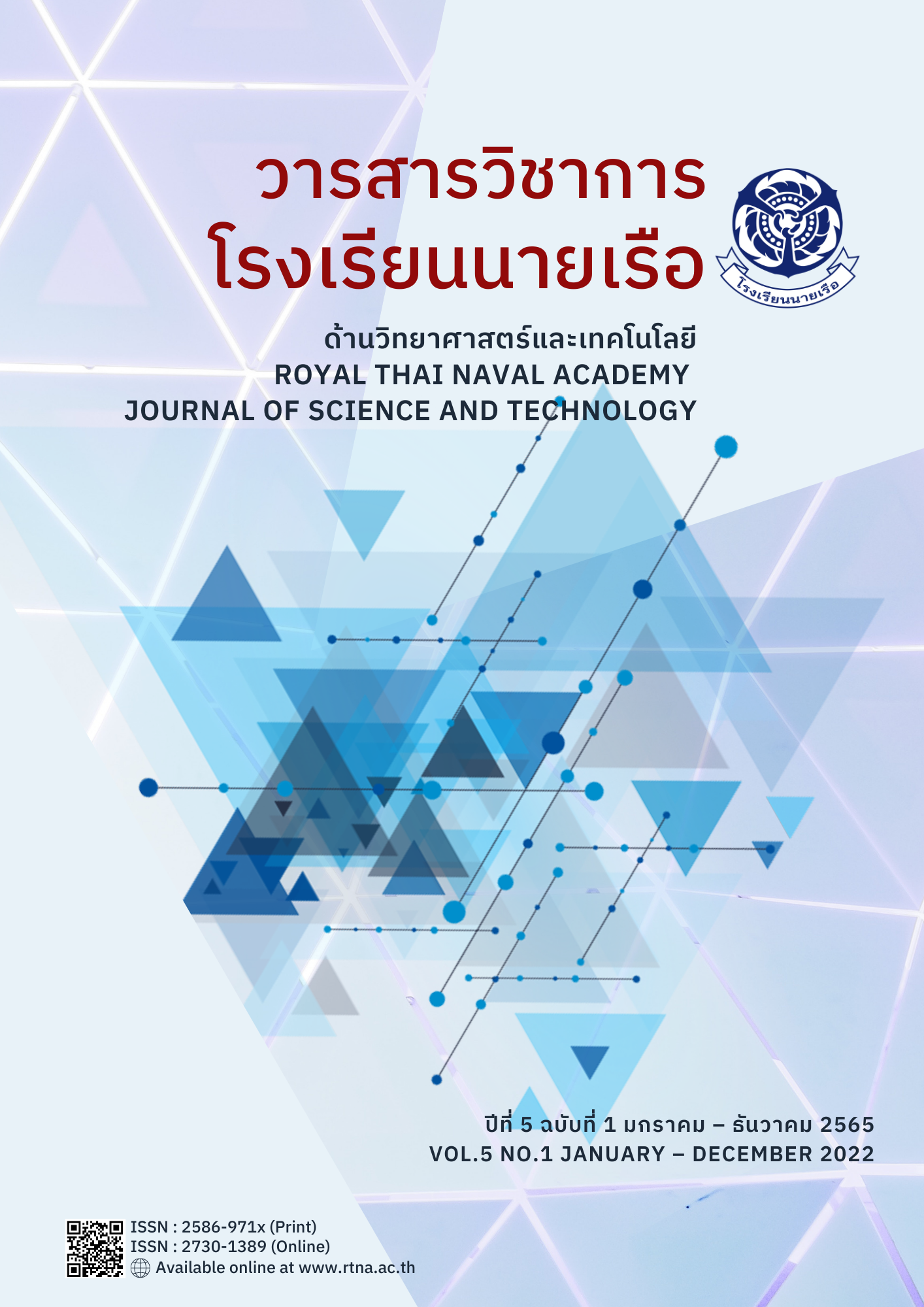เทคโนโลยีการรู้จำใบหน้ามนุษย์ด้วยการประมวลผลภาพ
Main Article Content
บทคัดย่อ
การรู้จำใบหน้าเป็นเทคโนโลยีได้รับความนิยมในด้านการเข้าถึงข้อมูลมัลติมีเดียในพื้นที่ต่าง ๆบนเครือข่ายในปัจจุบัน เช่น ความปลอดภัยของเครือข่าย การจัดทำดัชนีดึงข้อมูลเนื้อหา และการบีบอัดวิดีโอ ซึ่งประโยชน์จากเทคโนโลยีการจดจำใบหน้านั้นเกิดจาก “ผู้คน” เป็นศูนย์กลางของความสนใจในการเข้าถึงข้อมูลมัลติมีเดียต่าง ๆ เพราะฉะนั้นการควบคุมการเข้าถึงเครือข่ายด้วยเทคโนโลยีการรู้จำใบหน้านั้น ไม่เพียงแต่จะทำให้ผู้ก่อการร้ายแทบเป็นไปไม่ได้ที่จะขโมย “รหัสผ่าน” แต่ยังเพิ่มความคล่องตัวต่อผู้ใช้ในการปฏิสัมพันธ์ระหว่างมนุษย์กับคอมพิวเตอร์อีกด้วย การจัดทำดัชนีหรือดึงข้อมูลวิดีโอตามลักษณะที่ปรากฏของบุคคลใดบุคคลหนึ่งจะเป็นประโยชน์สำหรับผู้ใช้ เช่น ผู้รายงานข่าว นักวิทยาศาสตร์ และผู้ชมภาพยนตร์ สำหรับการใช้งานวิดีโอโฟนและการประชุมทางไกล โดยใช้เทคโนโลยีการรู้จำใบหน้ายังให้รูปแบบการเข้ารหัสที่มีประสิทธิภาพยิ่งขึ้นอีกด้วย ในบทความวิจัยนี้จะนำเสนอข้อมูลเกี่ยวกับการประมวลผลข้อมูลภาพที่จะแสดงให้ผู้อ่านเห็นถึงกรอบการทำงานทั่วไปสำหรับระบบรู้จำใบหน้า และรูปแบบต่าง ๆ ที่มักพบในเครื่องรู้จำใบหน้า โดยจะมีการอธิบายขั้นตอนวิธีการรู้จำใบหน้าที่มีชื่อเสียงหลายอย่าง เช่น ไอเกนเฟซ (Eigenface) และโครงข่ายประสาทเทียม ทำการทดสอบขั้นตอนการรู้จำภาพใบหน้ามีการแสดงออกทาง
สีหน้าที่หลากหลายเพื่อเปรียบเทียบกัน พบว่าอัตราข้อผิดพลาดวิธีการผสมผสานกันระหว่าง Self - Organizing Map และโครงข่ายประสาทเทียม มีอัตราความผิดพลาดน้อยสุดที่ร้อยละ 4.5 ใช้เวลาในการจำแนกน้อยสุดที่ 0.7 วินาที และใช้เวลาในการฝึก 6 ชั่วโมง วิธีการของไอเกนเฟสจะมีอัตราความผิดพลาดที่ร้อยละ 9 แต่ก็ใช้เวลาในการฝึก 40 นาที เร็วที่สุดในทุกวิธีการที่ใช้ ซึ่งการเลือกขั้นตอนวิธีการใดในการใช้งานก็ขึ้นกับตัวเจ้าของผลงานที่จะเลือกให้เหมาะสมกับงานของตัวเองมากที่สุด และวิธีโครงข่ายประสาทเทียมได้ผลอัตราความถูกต้องมากกว่าวิธีอื่น
Article Details

อนุญาตภายใต้เงื่อนไข Creative Commons Attribution-NonCommercial-NoDerivatives 4.0 International License.
เนื้อหาและข้อมูลในบทความที่ลงตีพิมพ์ในวารสารวิชาการโรงเรียนนายเรือ ด้านวิทยาศาสตร์และเทคโนโลยี ถือเป็นข้อคิดเห็นและความรับผิดชอบของผู้เขียนบทความโดยตรง ซึ่งกองบรรณาธิการวารสาร ไม่จำเป็นต้องเห็นด้วย หรือร่วมรับผิดชอบใด ๆ
บทความ ข้อมูล เนื้อหา รูปภาพ ฯลฯ ที่ได้รับการตีพิมพ์ในวารสารวิชาการโรงเรียนนายเรือ ด้านวิทยาศาสตร์และเทคโนโลยี ถือเป็นลิขสิทธิ์ของโรงเรียนนายเรือ หากบุคคลหรือหน่วยงานใดต้องการนำทั้งหมดหรือส่วนหนึ่งส่วนใดไปเผยแพร่ต่อหรือเพื่อกระทำการใด ๆ จะต้องได้รับอนุญาตเป็นลายลักษณ์อักษรจากโรงเรียนนายเรือก่อนเท่านั้น
เอกสารอ้างอิง
Belhumeur PN, Hespanha JP, Kriegman DJ. Eigenfaces vs. Fisherfaces: recognition using class specific linear projection. IEEE Trans Pattern Anal Mach Intell [Internet]. 1997 [cited 2022 Apr 5];19(7):711–20. Available from: http://dx.doi.org/10.1109/34.598228
Brunelli R, Poggio T. Face recognition: features versus templates. IEEE Trans Pattern Anal Mach Intell [Internet]. 1993 [cited 2022 Apr 9];15(10):1042–52. Available from: http://dx.doi.org/10.1109/34.254061
Chan Y, Lin SH, Kung SY. Video Indexing and Retrieval. Multimedia Technology for Applications. 1998:253-81.
Chellappa R, Wilson CL, Sirohey S. Human and machine recognition of faces: a survey. Proc IEEE Inst Electr Electron Eng [Internet]. 1995 [cited 2022 Apr 11];83(5):705–41. Available from: http://dx.doi.org/10.1109/5.381842
Dempster AP, Laird N, Rubin D. Maximum Likelihood from Incomplete Data via the EM Algorithm. J R Stat Soc Ser C Appl Stat [Internet]. 1977 [cited 2022 Apr 16];39(1):1-38. Available from: https://www.jstor.org/stable/2984875
Kelly MD. Visual Identification of People by Computer [Doctoral thesis]. CA: Standford University; 1970.
Lades M, Vorbruggen JC, Buhmann J, Lange J, von der Malsburg C, Wurtz RP, et al. Distortion invariant object recognition in the dynamic link architecture. IEEE Trans Comput [Internet]. 1993 [cited 2022 Apr 20];42(3):300–11. Available from: http://dx.doi.org/10.1109/12.210173
Li H, Roivainen P, Forchheimer R. 3-D motion estimation in model-based facial image coding. IEEE Trans Pattern Anal Mach Intell [Internet]. 1993 [cited 2022 Apr 30];15(6):545–55. Available from: http://dx.doi.org/10.1109/34.216724
Lin SH, Kung SY, Lin LJ. Face recognition/detection by probabilistic decision-based neural network. IEEE Trans Neural Netw [Internet]. 1997 [cited 2022 May 3];8(1):114–32. Available from: http://dx.doi.org/10.1109/72.554196
Pentland A, Moghaddam B, Starner T. View based and Modular Eigenspaces for Face Recognition. IEEE Comput Soc Conf Comput Vis Pattern Recognit [Internet]. 1994 [cited 2022 May 10];245:[about 7 p.]. Available from: https://vismod.media.mit.edu/pub/facereco/ papers/TR-245.pdf
Rowley HA, Baluja S, Kanade T. Rotation invariant neural network-based face detection. In: Proceedings 1998 IEEE Computer Society Conference on Computer Vision and Pattern Recognition (Cat No98CB36231). IEEE Comput. Soc; 2005.
Reuters News [Internet]. London: Reuters; c2022. Computer Security Threat On Rise – U.S. Survey; 1999 [cited 2022 May 19]. Available from: https://www.reuters.com/
Sung K-K, Poggio S. Learning a distribution-based face model for human face detection. In: Proceedings of 1995 IEEE Workshop on Neural Networks for Signal Processing. IEEE; 2002.
Zhang J, Yan Y, Lades M. Face Recognition: Eigenfaces, Elastic Matching, and Neural Nets. Proc. IEEE [Internet]. 1997 Sep [cited 2022 May 25];85(9):1423-35. Available from: https://www.academia.edu/7052960/Face_recognition_eigenface_elastic_matching_and_neural_nets
Yan H, Wang P, Chen WD, Liu J. Face Recognition Based on Global Wavelet Transform and Modular 2DPCA. In: International Conference on Power Electronics and Energy Engineering; 2015 Apr 19-20; Hong Kong, China: Atlantis Press; 2015. p. 245-8.
Gupta P, Saxena N, Sharma M, Tripathi J. Deep neural network for human face recognition. Int J Eng Manuf [Internet]. 2018 [cited 2022 May 30];8(1):63–71. Available from: http://dx.doi.org/ 10.5815/ijem.2018.01.06
Aledhari M, Razzak R, Parizi RM, Srivastava G. Deep Neural Networks for Detecting Real Emotions Using Biofeedback and Voice. In: , et al. Pattern Recognition. ICPR International Workshops and Challenges. ICPR 2021. Lecture Notes in Computer Science; 2021 Jan 10-15. New York: Springer; 2021.
Mondal SK, Mukhopadhyay I, Dutta S. Review and comparison of face detection techniques. In: Proceedings of International Ethical Hacking Conference 2019. Singapore: Springer Singapore; 2020. p. 3–14.
Ganakwar DG, Kadam VK. Comparative analysis of various face detection methods. In: 2019 IEEE Pune Section International Conference (PuneCon). IEEE; 2019.
Rai L, Wang Z, Rodrigo A, Deng Z, Liu H. Software development framework for real-time face detection and recognition in mobile devices. Int J Interact Mob Technol [Internet]. 2020;14(04):103. Available from: http://dx.doi.org/10.3991/ijim.v14i04.12077
Neagoe V-E, Mugioiu A-C, Stanculescu I-A. Face Recognition using PCA versus ICA versus LDA cascaded with the neural classifier of Concurrent Self-Organizing Maps. In: 2010 8th International Conference on Communications. IEEE; 2010.
Bevilacqua V, Cariello L, Carro G, Daleno D, Mastronardi G. A face recognition system based on Pseudo 2D HMM applied to neural network coefficients. Soft Comput [Internet]. 2008;12(7):615–21. Available from: http://dx.doi.org/10.1007/s00500-007-0253-0
Nefian AV, Hayes MH. Hidden Markov models for face recognition. In: Proceedings of the 1998 IEEE International Conference on Acoustics, Speech and Signal Processing, ICASSP ’98 (Cat No98CH36181). IEEE; 2002. p. 2721–4 vol.5.


